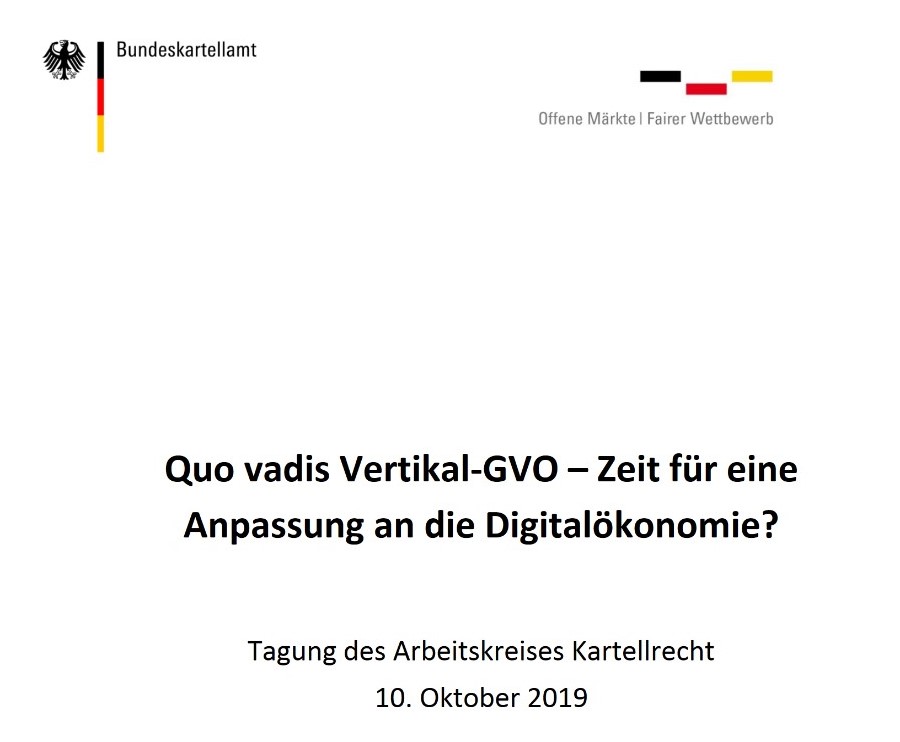
Quo vadis Vertical BER? – The Bundeskartellamt’s Background Paper
The Bundeskartellamt just held its annual meeting with professors and judges, this time discussing the Vertical Block Exemption Regulation. In preparation, the German authority issued a background paper. Florian Wagner-von Papp read the paper. Here is his report!
A note from the editor: On Monday, we posted a synopsis and translation of some important rules in the draft bill (GWB-Referentenentwurf) in our blog. There were a few mistakes in that document that we have now corrected. Apologies. We kindly ask you to work with this document and delete the other version from your files if you saved it (not to be mistaken in the future). Thanks! Now – back to Florian’s report!
I recently left the UK just in time to escape Brexit, but did so with a heavy heart (I miss the daily contact with my fabulous colleagues at University College London and in the British competition law scene). But, on the other hand, I did gain delightful new colleagues at the Helmut Schmidt University in Hamburg. As an additional sweetener, my new Chair at a German university appears to have qualified me for the Bundeskartellamt’s annual conference of the “Arbeitskreis Kartellrecht” — otherwise known as the “Professors’ Conference”, so called because private practitioners are excluded by design and the audience consists mostly of (nearly all) German-speaking professors with competition law expertise (well, and me), but also judges and representatives from various competition authorities, most prominently of course the Bundeskartellamt itself, with its Vice President Konrad Ost in the Chair.
This year, the conference’s theme was the revision of the vertical Block Exemption Regulation (vBER), with a particular focus on new challenges in the digital economy. As every year, the Bundeskartellamt had compiled in advance a very helpful background paper which touched on practically all points that were eventually discussed at the conference (the background paper can be accessed here (in German)).
Given the concise nature of the background paper (it covers a lot of ground in just 34 pages), those of you with German reading proficiency will probably prefer to read the background paper yourselves (as you should!). But there are people in this world who consider the word “Vertikal-Gruppenfreistellungsverordnung” to be one of those German words “so long that they have a perspective” (although Mark Twain is unlikely to have had this word in mind when he coined the phrase. To be fair, even Germans abbreviate Gruppenfreistellungsverordnung as “GVO”— but, they are allowed to use the extended form when playing Scrabble).

The background paper starts by pointing to the Commission’s current public consultation process regarding the review of the vertical BER when the current BER 330/2010 expires on 31 May 2022. The introduction also highlights the volume of e-commerce in Germany: in 2018, a turnover of €53.3bn (a nearly 10% increase from 2017), with Amazon alone accounting for €20bn. The background paper identifies three strands of new challenges for the application of the vBER in the digital economy: (1) the changing and new roles of actors in the digital economy; (2) new business practices (and new variations on old practices); and (3) a need to readjust the balance between flexibility and legal certainty.
(1) The changing and new roles of actors in the digital economy
First, platforms act as intermediaries either by simply matching the two sides of the market or by acting as an intermediary distribution layer.
This raises questions to what extent the vBER is applicable to the various types of platforms (a question that was discussed, with varying results, in a number of hotel booking platform cases), what the relevant market(s) for the determination of market shares is (are), and what the criteria for distinguishing between different types of platform are.
The background paper suggests that the most important relevant factors are: the degree of involvement in the transaction and the (legal and factual) responsibility for the transaction; a merely indicative function of the qualification in the platform’s terms and conditions; and whether the platform is necessarily involved in entering into the transaction. The provision of after-sale services by the platform is said to be ambivalent, because it shows, on the one hand, the platform’s interest in the individual transaction, but could also be explained, on the other hand, by the platform’s general interest in raising the volume of transactions so as to benefit from cross-platform network effects.
Secondly, more producers nowadays sell directly to end-consumers (online or in new brick and mortar shops, such as flagship stores), and hybrid platforms act as both matchmaker between the two sides of the market on account for the supplier and as a reseller on their own account. This raises the question how to approach the vertical and horizontal relationships in these cases of dual distribution. It is said that the new developments may require a rethink of the solution in the second sentence of Article 2(4) vBER, that is, to apply the safe harbour of the block exemption to these cases of dual distribution. (My own view is that it is not the new developments that make a rethink necessary – the vBER was always wrong entirely to disregard the horizontal aspect – but that is another story).
Thirdly, the paper raises the question to what extent platforms may rely on the privilege for genuine sales agents, given that they are often acting for several “principals”, that the normal hierarchical relationship between principal and agent is, if anything, reversed, and that they are usually not integrated into the principal’s undertaking.
(2) New (and new variations on old) business practices
The digital economy has introduced some new forms of restrictions, but has also provided a new slant on a few old-time favourites. These concerns were already summarised in the Commission’s Final Report on the e-commerce sector enquiry (paragraph 15), and the background paper considers these concerns from the viewpoint of (mainly German) case practice.
RPM
RPM, for example, is not a particularly new practice. However, as the background paper explains, in the digital economy its assessment may change somewhat. The background paper points out that the effects of the enforcement of RPM against an aggressively pricing maverick may be magnified by the use of ‘spiders’ that crawl the internet for competitors’ prices: even enforcing RPM against only a few particularly aggressively competing distributors may therefore have knock-on effects not only on other distributors of the same brand, but indirectly even on distributors of other brands (and hence on interbrand competition).
While the background paper for the most part argues for a stricter approach to many vertical practices, and in particular RPM (a position not entirely surprising given that it was drafted by the Bundeskartellamt), the paper also suggests that the Vertical Guidelines could be revised to include specific case scenarios of RPM in which an individual application of Article 101(3) TFEU appears likely.
Selective Distribution
Another old practice that, in the Bundeskartellamt’s view, presents new challenges in the digital economy is selective distribution. While the background paper acknowledges the benefits of selective distribution schemes, it considers some selective distribution schemes to be a means for stifling aggressive competition. It suggests that a revised vBER could include more demanding requirements before the carve-out for selective distribution schemes from the hardcore restriction is applied (a solution that would, of course, only apply to selective distribution schemes that do not already conform to the Metro I-criteria). The background paper notes that the Commission has never followed up on the threat in the Vertical Guidelines (para. 176) that the benefits of the vBER could be withdrawn if the requirements are unnecessarily restrictive in view of the product in question.
One big question already in the discussions
preceding the 2010 vBER and Guidelines was the question to what extent internet
distribution may be prohibited in the context of selective distribution, and
more generally (because of the qualification of internet sales as “passive
sales”) either completely or partially, in particular by prohibiting the use of
particular platforms such as Amazon or ebay, for example with the justification
that this would ruin the brand image. Cue the inevitable citations of the Court
of Justice’s decisions in Pierre
Fabre and Coty,
and the German Bundesgerichtshof’s decision in Asics
(and the questions if / how the decisions in Coty and Asics can be
reconciled, a question which was implicitly discussed in a Competition
Policy Brief in April 2018), but also to a more recent case in
France in which Stihl required
“personalised distribution” of dangerous gardening equipment in order to ensure
that Freddy Krueger receives proper instructions on how to use a chainsaw on
Elm Street customers are properly instructed how to use it safely (see the Autorité de
Concurrence’s decision (in French); however, the appeals
court in Paris has stayed the execution (in French)); the background
paper notes that the German, Swiss, and Swedish competition authorities had
declined to exercise their discretion to take up this case.
The background paperalso raises the question to what extent and how differing regional market circumstances with regard to consumer preferences and consumer behaviour can be taken into account in the assessment of platform prohibitions, such as the question whether customers can still find distributors sufficiently easily despite their being banned from particularly popular platforms.
Brand-bidding restrictions
Furthermore, the background paper raises the question whether brand-bidding restrictions (in the German original: “brand-bidding restrictions”) should be categorised as a hardcore restriction in the revised vBER. On the one hand, it points to the Commission’s Guess decision and the Bundeskartellamt’s Asics decision. On the other hand, it acknowledges that the British CMA considered the pros and cons to be more finely balanced, depending on the specific market conditions, leading only to the recommendation that non brand bidding should be kept under review (para. 5.29 and recommendation/action 13).
Dual pricing
The background paper devotes less than a page to dual pricing, but it turned out to be one of the bones of contention at the conference. Dual pricing refers to the practice of charging different prices to those who sell online and those who sell in brick and mortar stores. The Bundeskartellamt has a very negative view on dual pricing and suspects that it has effects similar to online-selling bans, reducing competition online (and indirectly softening competition offline), see the cases Gardena, Bosch Siemens and LEGO. The counter-argument is that dual pricing may simply be an attempt to create a level playing field between online and offline competition, rewarding services in brick and mortar stores that are valued by customers but would, in the absence of dual pricing, be crowded out by free riding.

Currently, dual pricing is considered to be a hardcore restriction as a restriction of passive sales (Vertical Guidelines para. 52, fourth indent), although fixed fees are permissible (see ibid.) and, of course, in principle one could attempt to rely on Article 101(3) TFEU in the individual case (Vertical Guidelines para. 64); however, this latter path is a dangerous one (see below part (3) on the deficiency of the safety valve Art. 101(3) TFEU).
Price parity / MFN clauses
Another issue that was predictably controversial at the conference were wide and narrow price parity/MFN clauses (wide MFN clauses prohibit offering more favourable terms on any other platform; narrow MFN clauses prohibit only better terms on the supplier’s own website). With regard to wide MFN clauses, the background paper points to the Bundeskartellamt’s assessments in Amazon, HRS, and Verivox, the CMA’s investigations in car and home insurance products, and the Commission’s cases Apple and Amazon (regarding ebooks) and Amadeus, Sabre (air ticket distribution), and considers classifying wide MFN clauses as hardcore restrictions.
With regard to narrow MFN clauses, the background paper notes their generally more nuanced effects. However, the background paper also points out that not only do they prevent the supplier from passing on efficiencies of direct online sales to its customers, but also they force the supplier, if it contracts with several platforms that each use a narrow MFN, to use on its own website the highest price asked for on any of the platforms, which reduces the supplier’s incentive to charge different prices on the various platforms, thereby softening competition between platforms. The Bundeskartellamt had issued an infringement decision against the narrow MFN clause used by booking.com in 2015; however, in June 2019, the OLG Düsseldorf quashed that decision, arguing that the restriction was a necessary ancillary restraint without which the booking platform could not operate (an English discussion of the case can be found here, calling the Court’s reliance on the ancillary restraints doctrine ‘unusual’). The Bundeskartellamt is seeking leave to appeal to the Bundesgerichtshof.
Exclusivity
In CTS Eventim, the Bundeskartellamt considered an exclusivity clause imposed by a concert ticketing platform, and prohibited its use (affirmed on appeal). The vBER did not apply to that case because the platform exceeded the market share threshold. The background paper considers that exclusivity clauses are more pernicious in platform markets, because there, in addition to the usual foreclosure effects of exclusivity clauses, they also prevent multi-homing and thereby reduce the scope of indirect network effects for competing platforms. The background paper therefore raises the question whether the timeframe envisaged for temporary exclusivity clauses in Article 5 lit. a vBER should be shortened to prevent a tipping of the market, given the network effects and the generally rapid developments in digital markets.
Sharing economy
Lastly, the background paper raises the issue of various emanations of the sharing economy, and the question whether the issue is one of horizontal coordination between those delivering the services (the platform as a hub & spoke conspiracy), or whether there is a vertical relationship between the platform and those who deliver the service (possibly including vertical price fixing). The background paper considers the vertical relationship to be more likely. It also indicates that the competition issue is less problematic if the platform only recommends prices to predominantly non-professional users who offer their services (such as Airbnb.com) than if more and more of those delivering the services do so on a professional basis (as tends to be the case with Uber drivers).
(3) A need to readjust the balance between flexibility and legal certainty?
As a third strand, the background paper raises the fundamental question whether the balance between legal certainty (both in the sense of the safe harbour below the market share threshold and in the sense of the hardcore restrictions) on the one hand and flexibility on the other hand needs to be struck differently in the digital economy.
In theory, the easy answer is that the system of the vBER contains a nice mechanism to balance legal certainty with flexibility: if a practice is in the safe harbour, but it turns out to be problematic in the specific market circumstances, the vBER may be disapplied under Article 6 vBER or the benefits of the vBER may be withdrawn under Article 29 Regulation 1/2003; and if a practice falls under a hardcore restriction, but its efficiency aspects outweigh the competitive restriction, the application of Article 101(3) TFEU in the individual case allows us to take this into account. (And then there is, of course, Article 5 vBER).
However, the background paper notes that in practice the safety valves of non-application and of the withdrawal of the benefits of the BER under Article 6 vBER and Article 29 Regulation 1/2003, respectively, are of hardly any practical relevance. (It could be added – and, indeed, was added at the conference by Petra Pohlmann – that this is similarly true for the safety valve of the individual application of Article 101(3) TFEU in the case of hardcore restrictions; and, as mentioned above, in the background paper itself there is a nod in this direction in the discussion of RPM). The Bundeskartellamt notes in particular that the possibility for NCAs of withdrawing the benefits of the BER under Article 29(2) Regulation 1/2003 is hampered by the fact that the relevant geographic market would have to be confined to one Member State, which makes the provision unusable for the Bundeskartellamt (at the conference, it was made clear that this is because the relevant geographic market in most cases covers at least the German-speaking Member States). The background paper suggests that if the case allocation mechanism allows NCAs to take up cases with relevance in other Member States, the possibility to withdraw the benefits of a BER should likewise not be confined to cases where the relevant market is confined to one Member State.
The background paper raises a number of issues when it comes to the balancing of legal certainty and flexibility, ranging from the fundamental (do we need a BER at all, or should we just rely on Guidelines? – a passing thought that was (rightly) quickly dismissed at the conference) to the practical.
Among these practical issues is, for example, the question how we should determine market shares on platform markets. On one level, this entails the question to what extent online and offline distribution are substitutes to each other. On another level it raises the question whether turnover is the right measure to indicate market power; in this respect, the paper mentions access to data, network effects, and the extent of multi-homing, and suggests that in addition to turnover thresholds, the number of unique visitors and/or the number of transactions might be a useful indicator.
Another issue criticised is that even falling short of the 30% threshold by just a minor delta takes the undertaking into the safe harbour, even if the market is overall fairly highly concentrated. The paper concedes that in principle Articles 6 vBER and Article 29 Regulation 1/2003 are meant to kick in precisely in these cases, but it notes that these safety valves are not used in practice. The paper therefore suggests that it should be considered to strengthen these instruments and/or to introduce additional oligopoly thresholds (it may be that § 18 of the German ARC was an inspiration there).
Conclusion
The background paper was written by members of a competition authority, and so it is not astonishing that in many cases the suggestions (even if formulated in the form of questions to be raised) tend to go into the direction of making enforcement easier, for example, by introducing new hardcore restrictions. However, in some cases the paper also raises issues that might lead to less strict enforcement, for example when the paper suggests that the Vertical Guidelines should be amended to include concrete examples under what conditions RPM benefits from the application of Article 101(3) TFEU in the individual case. Economists at the conference with whom I spoke tended to fault the paper and the discussion at the conference for not sufficiently taking into account the potential efficiencies of practices such as dual pricing or MFN clauses, and for being insufficiently interested in empirical evidence before calling for new hardcore categories. At least as a criticism against the background paper, this is unfair; it was only meant to establish a framework for the discussion to follow, and this objective was perfectly achieved: the discussion at the conference hardly ever touched on points that were not already mentioned in the background paper — and this still left plenty of space for very divergent views on most topics.

Florian Wagner-von Papp is Professor of Private and Business Law (including Contract Design) at the Helmut Schmidt University for the Armed Forces in Hamburg.
2 thoughts on “Quo vadis Vertical BER? – The Bundeskartellamt’s Background Paper”